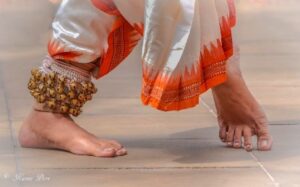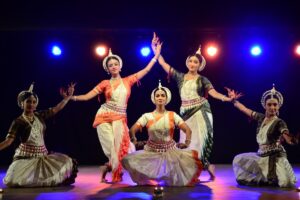Odissi is a classical dance form that originated in the Indian state of Odisha. It is known for its graceful and fluid movements, as well as its elaborate hand gestures and facial expressions. The dance is typically performed to classical Indian music and tells stories from Hindu mythology, such as the stories of Krishna and Radha.
The origins of Odissi dance can be traced back to the temples of Odisha, where it was performed as a form of worship by the devadasis, or temple dancers. These women were trained in the art of dance and music and dedicated their lives to serving the deity in the temple.
During the colonial period, temple dancing was outlawed, and the devadasis were marginalized. As a result, the art of Odissi dance went into decline. It was only in the mid-twentieth century that Odissi dance was revived, thanks to the efforts of a few dedicated individuals who recognized its cultural significance.
One of the unique features of Odissi dance is its emphasis on ‘’tribhangi’’, which refers to the three bends in the body – the head, torso, and knees – that give the dance its fluidity and grace. The footwork in Odissi is also very intricate, with the dancer using the entire foot to create rhythmic patterns. It is also known for its use of “mudras,” or hand gestures, which are used to convey emotions and convey the story being told through the dance. Another key aspect of Odissi dance is its expressive storytelling. The dancer uses subtle facial expressions and hand gestures, known as mudras, to convey emotions and tell a story. This makes Odissi dance not just a visual art but also a narrative one.
The dance also incorporates elements of music and poetry. The dance is typically performed to the accompaniment of traditional Indian music, and the costume worn by the dancers includes a sari or dhoti and various ornaments. Odissi is known for its graceful and expressive abhinaya, or facial expressions, and its use of bhava, or emotional content. The dance form also incorporates elements of Hindu mythology and the ancient Sanskrit texts known as the Natya Shastra.
Odissi has a long and rich history, and it is believed to have been performed in temples as a form of worship for centuries. The dance form which dates back to ancient times, has evolved over the centuries to become the form that it is today. Odissi is also recognized for its intricate and expressive hand and eye movements, as well as its distinctive sculpturesque poses, which are inspired by the ancient temple carvings of Odisha.
Odissi is considered an important part of India’s cultural heritage and is valued for its beauty, artistic expression, and historical and cultural significance. In recent years, Odissi has gained popularity both within India and internationally, and it is now recognized as one of the eight classical dance forms of India. Odissi dance is an integral part of Indian culture and is celebrated as a form of artistic expression and spiritual devotion. It has been recognized as a UNESCO intangible cultural heritage, which highlights its importance as a cultural treasure.






